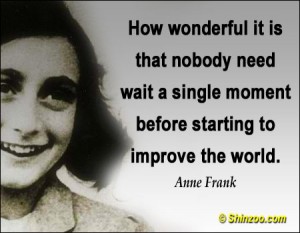What inspiring words from one so young. What a great way to look at each day! As we enter into September and the season of fall, each of us has many opportunities to not waste another minute before we start to improve the world.
We can do that in our personal lives: study hard at school, learn a new skill, ready our gardens for the cooler weather, through word or deed let your family know how much you love them.
We can do that in our community: volunteer in a community center, support your local food drive, keep an eye on your elderly neighbor, participate in a 5K to raise funds for a charity event.
We can do that in our place of business: smile and say good morning to everyone you meet in the elevator each day, offer words of encouragement to a co-worker struggling with a task, volunteer to take on a task before your boss has to ask you, put on a fresh pot of coffee after you’ve poured the last cup.
Here at STAT we are improving the world for our clients with new service options and with renovations leading to a beautifully updated facility. Not a client yet? Visit our website, www.stat.international, to learn about how WE can help YOU improve the world by taking on your officing responsibilities and giving you more time to improve service your customers!
So your challenge is… how do YOU plan to improve the world in the near future?
Annelies Marie “Anne” Frank; June 12,1929 – February 1945) was a German-born diarist and writer. She is one of the most discussed Jewish victims of the Holocaust. Her wartime diary The Diary of a Young Girl has been the basis for several plays and films. Born in the city of Frankfurt in Germany, she lived most of her life in or near Amsterdam, in the Netherlands. Born a German national, Frank lost her citizenship in 1941 and thus became stateless. She gained international fame posthumously after her diary was published. It documents her experiences hiding during the German occupation of the Netherlands in World War II.
The Frank family moved from Germany to Amsterdam in 1933, the year the Nazis gained control over Germany. By May 1940, they were trapped in Amsterdam by the German occupation of the Netherlands. As persecutions of the Jewish population increased in July 1942, the family went into hiding in some concealed rooms behind a bookcase in the building where Anne’s father worked. After two years, the group was betrayed and transported to concentration camps. Anne Frank and her sister, Margot Frank, were eventually transferred to the Bergen-Belsen concentration camp, where they died (probably of typhus) in February or March 1945.
Otto Frank, the only survivor of the family, returned to Amsterdam after the war to find that Anne’s diary had been saved by one of the helpers, Miep Gies, and his efforts led to its publication in 1947. It has since been translated into many languages. It was translated from its original Dutch version and first published in English in 1952 as The Diary of a Young Girl. The diary, which was given to Anne on her thirteenth birthday, chronicles her life from June 12, 1942 until August 1, 1944.

